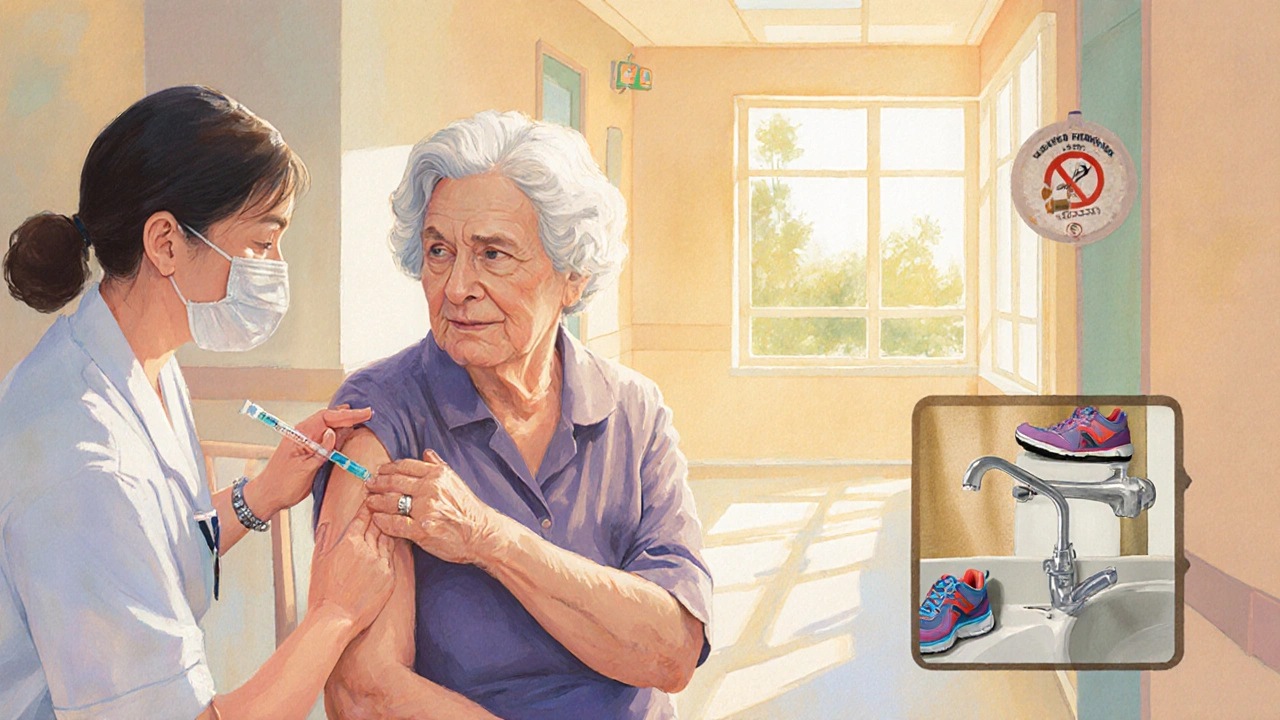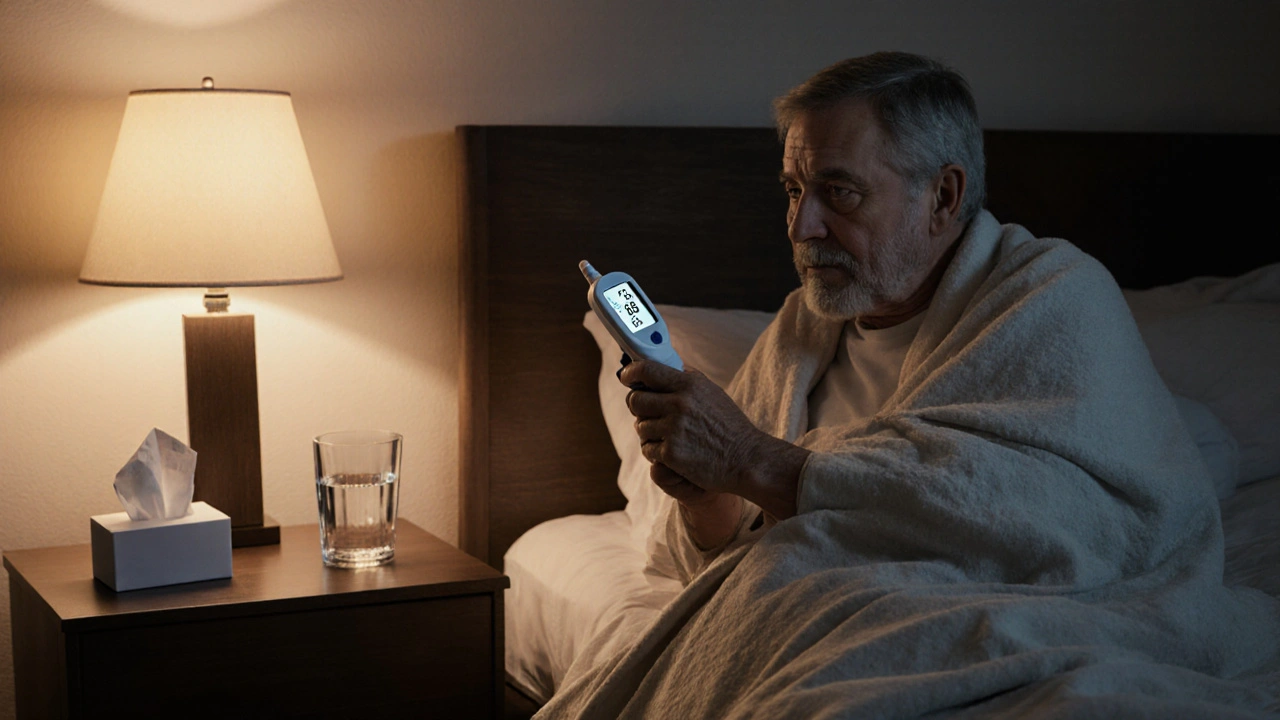Pneumonia Early Warning Signs Checker
Instructions
Select all symptoms you've experienced in the past 48 hours and check risk factors that apply to you. This tool helps identify potential early signs of pneumonia and assess your risk level.
Risk Assessment
Low Risk: 0-2 symptoms + no major risk factors
Moderate Risk: 3-4 symptoms + no major risk factors or 1-2 risk factors
High Risk: 5+ symptoms or 3+ risk factors
Select Your Symptoms (Past 48 Hours)
Check Risk Factors
Click "Assess My Risk Level" to see your risk assessment.
Important Note
This tool is for informational purposes only and does not replace professional medical advice. If you're experiencing severe symptoms or are concerned about your health, please contact a healthcare provider immediately.
When a cough or fever lingers longer than a typical cold, many people shrug it off as just a stubborn virus. But that extra day or two could be the body’s early SOS for pneumonia, a infection that can quickly turn serious if missed. Learning to spot the subtle clues before they explode into full‑blown breathlessness can save a night in the ER and a lot of worry.
What Is Pneumonia?
Pneumonia is an inflammatory condition of the lung tissue caused by bacteria, viruses, fungi, or inhaled substances that fill the alveoli with fluid or pus. The infection blocks oxygen transfer, leading to cough, fever, and sometimes a dangerous drop in blood oxygen levels. It affects all ages, but older adults and people with weakened immune systems face the steepest risk.
Key Early Warning Signs to Watch
Most people think pneumonia starts with a raging cough, but the earliest signals are often milder and easy to miss. Keep an eye on these five red‑flag clues:
- Persistent fever above 38°C (100.4°F) that lasts more than 48 hours, even if you’re taking over‑the‑counter meds.
- A cough that is dry at first, then turns productive with yellowish or greenish sputum.
- Shortness of breath that feels out of proportion to the effort you’re doing - climbing stairs or even walking across a room can leave you winded.
- Sharp chest pain that worsens when you take a deep breath or cough, known as pleuritic pain.
- Unexplained fatigue and a feeling of “being under the weather” that doesn’t improve with rest.
These symptoms often appear together, but even a single one, especially in a high‑risk person, warrants a closer look.
How Early Pneumonia Symptoms Differ From a Common Cold or Flu
Both colds and the flu can cause cough and fever, yet subtle differences help you tell them apart. The table below lays out the most telling contrasts.
| Feature | Bacterial Pneumonia | Viral Pneumonia |
|---|---|---|
| Fever | High, sudden (≥39°C), often spikes | Moderate, may fluctuate |
| Cough | Productive with thick, rust‑colored sputum | Dry at onset, becomes mildly productive |
| Breathlessness | Rapid onset, severe on light activity | Gradual, worse with exertion |
| Chest Pain | Pleural, sharp, worsens on inhalation | Less common, mild discomfort |
| Onset | Within 1-3 days after initial symptoms | Often follows a viral upper‑respiratory infection |
Risk Factors That Raise the Likelihood of Early Pneumonia
Knowing who is more likely to develop pneumonia helps you stay extra vigilant. The biggest risk factors include:
- Age≥65years - immune response naturally wanes.
- Chronic lung diseases like COPD, asthma, or bronchiectasis.
- Smoking - damages airway cilia and reduces clearance.
- Cardiovascular disease or diabetes - impair circulation and wound healing.
- Recent viral infection (e.g., flu or COVID‑19) that weakens the lungs.
- Immunosuppression from chemotherapy, steroids, or HIV.
If you fit any of these categories, treat a lingering cough or fever as a potential early alarm.
When to Call a Doctor - Red‑Flag Situations
Most early signs can be monitored at home, but certain developments demand immediate medical attention:
- Temperature soaring above 40°C (104°F) or failing to come down with medication.
- Rapid breathing (>30 breaths per minute) or a heart rate that’s unusually high for your age.
- Confusion, disorientation, or a sudden drop in alertness.
- Blue‑tinged lips or fingertips - a sign of low oxygen saturation.
- Chest pain that intensifies or radiates to the back.
In these cases, head to the nearest urgent‑care centre or call emergency services. Early treatment, especially with the right antibiotic for bacterial causes, dramatically improves outcomes.
Simple At‑Home Checks You Can Do Right Now
Before you book an appointment, a few quick checks can help you gauge severity:
- Take your temperature with a digital thermometer - note the exact reading and time.
- If you have a pulse oximeter, record the oxygen saturation (SpO₂). Values below 94% signal trouble.
- Count your breaths for a full minute while sitting still. Over‑breathing (>20 breaths per minute) is a warning.
- Observe the colour and amount of sputum. Blood‑tinged or rust‑coloured sputum is a concern.
- Write down any new chest pain, its location, and what makes it worse.
Bring this information to your clinician - it speeds up diagnosis and helps decide whether a chest X‑ray or blood test is needed.

Prevention: Vaccines and Lifestyle Tweaks
While catching pneumonia early is vital, preventing it is even better. Two vaccines play a starring role:
- The 13‑valent pneumococcal conjugate vaccine (PCV13) - recommended for infants, older adults, and anyone with a compromised immune system.
- The 23‑valent pneumococcal polysaccharide vaccine (PPSV23) - often given to adults 65+ or younger adults with chronic illnesses.
Annual flu shots also cut down the chance of a secondary bacterial pneumonia that often follows influenza. Pair vaccination with quitting smoking, regular exercise, and good hand hygiene, and you’ll lower the odds of the infection striking in the first place.
Quick Checklist for Early Pneumonia Detection
- Persistent fever >48hrs?
- New or worsening cough with coloured sputum?
- Shortness of breath on minimal effort?
- Chest pain that hurts on deep breath?
- Risk factors present (age, smoking, chronic disease)?
- SpO₂ < 94% or rapid breathing?
- Red‑flag symptoms (confusion, blue lips, very high fever)?
If you tick more than two boxes, schedule a medical evaluation promptly. Early detection can mean the difference between a quick course of antibiotics and a prolonged hospital stay.
Frequently Asked Questions
Can pneumonia be caught from a cold?
A cold itself doesn’t turn into pneumonia, but the viral infection can weaken the lungs, making it easier for bacteria to settle in and cause pneumonia. That’s why doctors watch for new symptoms after a cold.
What’s the difference between community‑acquired and hospital‑acquired pneumonia?
Community‑acquired pneumonia (CAP) develops outside healthcare settings, typically from everyday exposure to bacteria like Streptococcus pneumoniae. Hospital‑acquired pneumonia (HAP) occurs 48hours or more after admission, often involving more resistant organisms.
Do infants show the same early signs as adults?
Infants may not be able to verbalise pain, but look for rapid breathing, a persistent fever, poor feeding, and a noticeable change in skin colour. Any of these in a baby should trigger a pediatrician call.
Is a chest X‑ray always required for diagnosis?
A chest X‑ray is the gold standard for confirming pneumonia, but doctors may start treatment based on clinical assessment if the patient is severely ill and waiting isn’t safe.
Can pneumonia be treated at home?
Mild bacterial pneumonia in healthy adults can sometimes be managed with oral antibiotics and close monitoring. However, any sign of worsening breathing or fever should prompt a return to the doctor.


Maricia Harris
October 6, 2025 AT 13:28Wow, another long article that could've been a tweet.
Tara Timlin
October 18, 2025 AT 03:15Thanks for the thorough rundown!
One thing to add is that home pulse‑ox readings can be a game‑changer-if you see a SpO₂ dip below 94 %, it’s time to call the doc even if you feel okay.
Jean-Sébastien Dufresne
October 29, 2025 AT 16:01Seriously?? This piece covers EVERYTHING!!! 😱
From fever thresholds to vaccine schedules-so many details!!!
Great job, keep the info coming!!! 👍
Patrick Nguyen
November 10, 2025 AT 05:48The article correctly emphasizes early detection; prompt medical evaluation remains essential.
Patrick Bread
November 21, 2025 AT 19:35Oh sure, just pop a pill and you’re fine-if you’re not over 65, diabetic, or a smoker.
Fiona Doherty
December 3, 2025 AT 09:21Honestly, if you’ve got a stubborn cough and any of those risk factors, stop pretending it’s just a cold and get checked.
Neil Greer
December 14, 2025 AT 23:08Great info, mate! Also, keep an eye on any blood‑tinged sputum-it’s a red flag you don’t want to ignore.